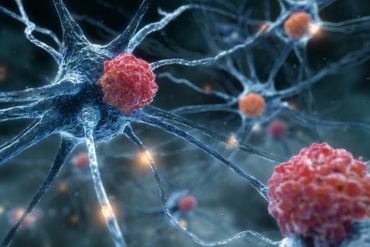Summary: Researchers claim they have identified a causal link between running speed and enhanced learning in mice.
Source: Champalimaud Center for the Unknown.
A new study, published in the journal Nature Neuroscience by a team from the Champalimaud Centre for the Unknown, in Lisbon, Portugal, has shown that the faster mice run, the faster and better they are at learning.
“Our main finding was that we could make mice learn better by having them run faster”, sums up Catarina Albergaria, first author of the new study.
The finding was serendipitous: the neuroscientists were studying something else altogether. “Our initial goal was to relate cellular plasticity in the brain to learning”, adds Albergaria. Ultimately, they sought to understand how neural circuits in a part of the brain called the cerebellum are changed by the learning of a motor task.
“The cerebellum is important for learning skilled movements”, says Megan Carey, who led the study. “It calibrates movements in the face of a changing environment to coordinate them in a very precise way”.
To understand the cellular changes in the cerebellum that accompany learning, the researchers were studying a classical conditioning learning task, akin to Pavlov’s famous dog conditioned behavior of salivating when it heard a bell just because it had learned to associate that sound with being fed.
In these experiments, while running on a treadmill, the mice had to learn to close their eyelids in response to a light which was flashed right before they received an air puff to the eye (which normally evokes a reflexive blink). This is a form of learning that takes place in the cerebellum.
However, the experiments the scientists undertook to look into this question just didn’t work. The team couldn’t see any effects of the learning task because there was too much variability in the data they obtained from different mice – and even from trial to trial from the same animal. What created this “contaminant noise” they apparently couldn’t get rid of? “The experiments were not working for a long time”, recalls Albergaria.
At a certain point, they understood what was happening: the mutant mice they were using couldn’t really run very well. When they took into account their running speed, the “noise” in the data cleared. Further, when all the animals were set to run at the same, faster speeds, they had similar learning curves and maximum eyelid conditioning performance. “This was a pretty surprising result”, says Carey.
This confirmed that there was a causal link between running speed and enhanced learning – and not just a correlation. “The finding that externally imposed changes in running speed are sufficient to modulate learning (…) provide[s] causal evidence that increases in locomotor activity enhance learning”, the authors write in their paper.
The team further showed that once the mice had learned the task, their subsequent performance of that task still depended on their running speed. “The mice performed less well when we slowed down the treadmill, and this happened at time scales of a few seconds”, says Albergaria.
That’s how the very thing they had been trying to get rid of – the apparently random variability in learning and performance – “became the story”, says Albergaria. “Now we wanted to figure out what the brain mechanism behind this link between running and learning was.”
Their next question was: where in the brain was this enhancement happening? First, the scientists asked whether the effect of running on learning was specific to the visual system. For example, was it just that the mice could see better when running, and thus learned better?
They now trained the mice to close their eyelids when experiencing other types of sensory stimuli (such as hearing a tone or feeling a vibration on their whiskers) before the air puff. And indeed, they found the same effect of running speed on learning in all of these different sensory modalities, just as they had with the visual stimuli.
What this commonality meant was that the neural process driving the learning enhancement was independent of the sensory system involved, suggesting that it might take place after the sensory signals had been processed by visual, auditory or tactile areas in cerebral cortex. The researchers then turned to the cerebellum.
Using the technique of optogenetics, which allowed them to directly stimulate specific neurons with laser light, they stimulated neurons that project to the cerebellum through axons dubbed mossy fibers.
“We substituted motor activity with direct stimuli to the cerebellum and we found that if you are able to increase the activity of the mossy fibers, you enhance learning”, explains Albergaria.”We found the place in the cerebellum where this modulation takes place”, emphasizes Carey.
What about humans? “The cerebellum is a well-conserved structure across species and there are circuits that are common across species”, replies Albergaria, speculating that the finding “could well apply to other forms of cerebellar learning in humans”. One implication of their findings was that “it doesn’t necessarily need to be locomotion; anything that drives an increase in mossy fiber activity could provide an equivalent modulation of learning,” says Albergaria. However, she cautions, “we don’t know whether this is true for other, non cerebellar, kinds of learning”.

If it were so, this could have general implications for learning in humans. Ever wonder why you sometimes need to pace around the room when you have a difficult problem to solve? Might it be because we think better when we walk, because we are better at organizing our ideas on the move?
“We tend to think that to manipulate the plasticity of the brain, so that people learn faster and slow learners improve, we have to use drugs”, says Carey. “But here, all we had to do was control how fast mice were running to obtain an improvement. It would be interesting to see if this holds for humans, for cerebellar forms of learning – and even for other types of learning.”
Source: Maria João Soares – Champalimaud Center for the Unknown
Publisher: Organized by NeuroscienceNews.com.
Image Source: NeuroscienceNews.com image is credited to Gil Costa.
Original Research: Abstract for “Locomotor activity modulates associative learning in mouse cerebellum” by Catarina Albergaria, N. Tatiana Silva, Dominique L. Pritchett & Megan R. Carey in Nature Neuroscience. Published April 16 2018.
doi:10.1038/s41593-018-0129-x
[cbtabs][cbtab title=”MLA”]Champalimaud Center for the Unknown “Run Faster, Learn Better.” NeuroscienceNews. NeuroscienceNews, 16 April 2018.
<https://neurosciencenews.com/fast-running-learning-8804/>.[/cbtab][cbtab title=”APA”]Champalimaud Center for the Unknown (2018, April 16). Run Faster, Learn Better. NeuroscienceNews. Retrieved April 16, 2018 from https://neurosciencenews.com/fast-running-learning-8804/[/cbtab][cbtab title=”Chicago”]Champalimaud Center for the Unknown “Run Faster, Learn Better.” https://neurosciencenews.com/fast-running-learning-8804/ (accessed April 16, 2018).[/cbtab][/cbtabs]
Abstract
Locomotor activity modulates associative learning in mouse cerebellum
Changes in behavioral state can profoundly influence brain function. Here we show that behavioral state modulates performance in delay eyeblink conditioning, a cerebellum-dependent form of associative learning. Increased locomotor speed in head-fixed mice drove earlier onset of learning and trial-by-trial enhancement of learned responses that were dissociable from changes in arousal and independent of sensory modality. Eyelid responses evoked by optogenetic stimulation of mossy fiber inputs to the cerebellum, but not at sites downstream, were positively modulated by ongoing locomotion. Substituting prolonged, low-intensity optogenetic mossy fiber stimulation for locomotion was sufficient to enhance conditioned responses. Our results suggest that locomotor activity modulates delay eyeblink conditioning through increased activation of the mossy fiber pathway within the cerebellum. Taken together, these results provide evidence for a novel role for behavioral state modulation in associative learning and suggest a potential mechanism through which engaging in movement can improve an individual’s ability to learn.







